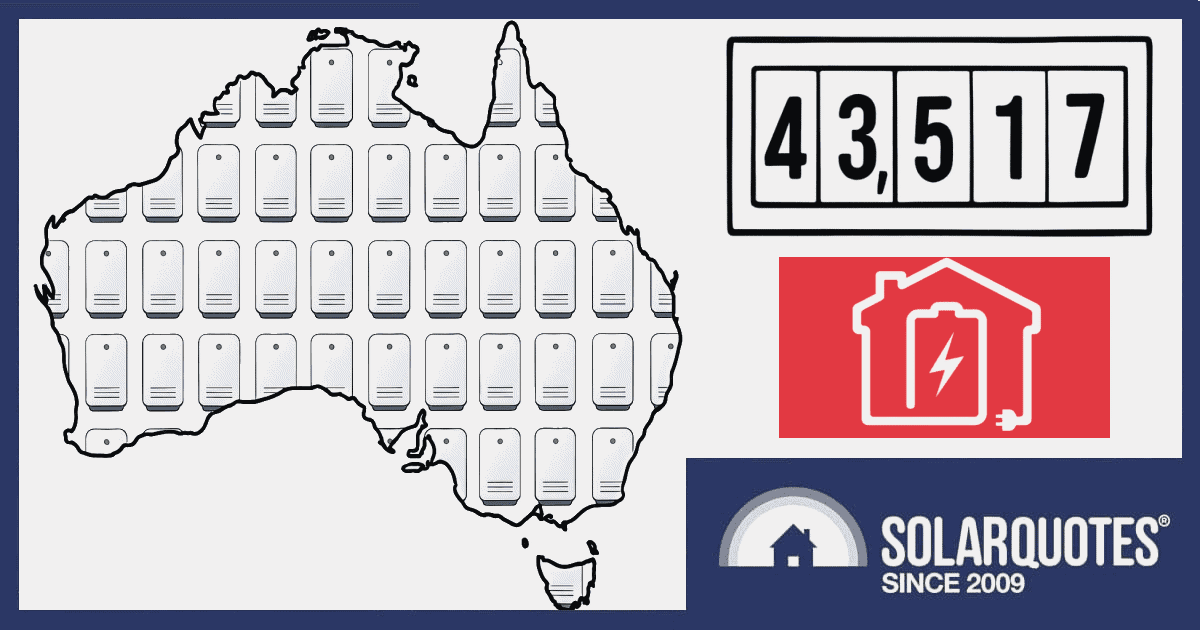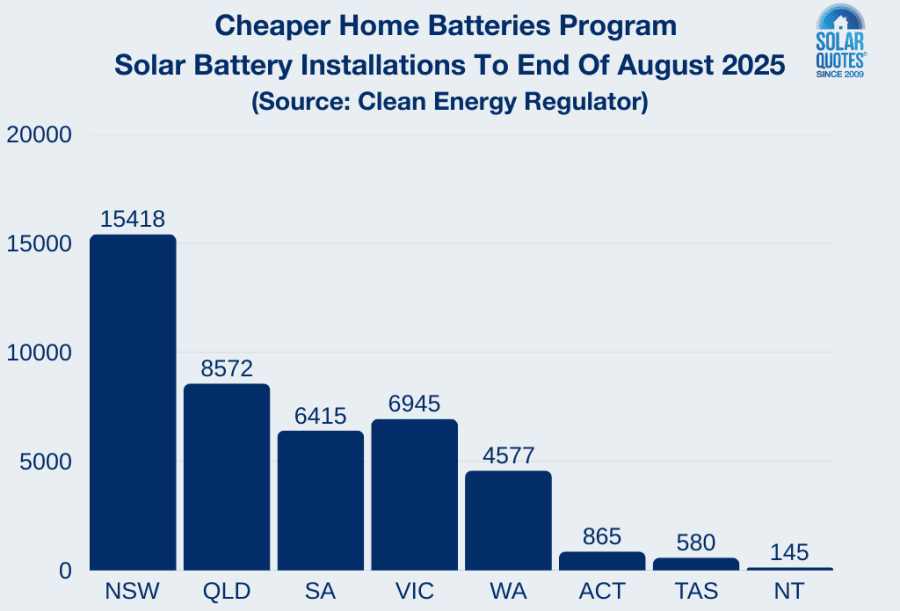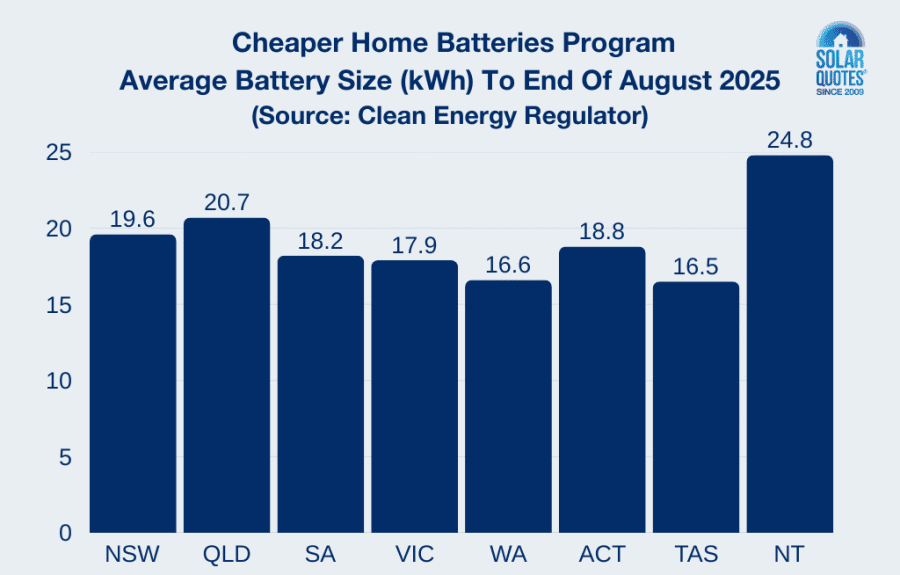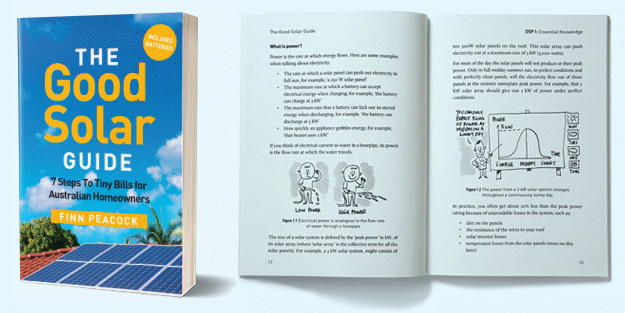
The number of solar battery installations since the launch of the federal government’s Cheaper Home Batteries program continues to skyrocket. See the latest figures from Australia’s Clean Energy Regulator (CER).
How Many Solar Batteries Have Been Installed?
The CER reported last week that a total of 43,517 home batteries have been installed with a new or existing rooftop solar system since the rebate’s launch on July 1, 2025 to the end of August; representing 825 MWh of nominal capacity.
- July installations: 19,592
- August installations: 23,925
Late last month, Federal Minister for Climate Change and Energy Chris Bowen said 40,004 solar batteries had been installed in just 8 weeks under the program, so there was quite an uptick during the final days of August.
Average battery capacity is also continuing to head upwards. Prior to the scheme, the average nominal capacity was around 11 – 12 kWh. During July, that jumped to 18.2 kWh, and with the addition of August’s installs it has increased again to 19.2 kWh.
The CER’s figures includes installations with both approved and pending applications for small-scale technology certificates (STCs) under Australia’s Small Scale Renewable Energy Scheme (SRES)1, but not those with failed STC applications, or those that haven’t applied yet. Under the SRES, STCs can be created up to 12 months after installation, not that many installers would be holding back. The Clean Energy Regulator has also previously advised there is a bit of a backlog on processing STC claims.
UPDATE: According to a press release from Minister Bowen over the weekend, 50,000 batteries had been installed in homes, businesses and community groups across the country under the program as at September 6, for a total capacity of 900 MWh.
NSW Still Leads On Installations
New South Wales continues to lead the states and territories by a large margin with 15,418 installations so far, followed by Queensland (8,572) and then Victoria (6,945).
NT Tops Average Capacity, But..
The Northern Territory is still leading the pack on average capacity: a whopping 24.8 kWh; followed by Queensland (20.7 kWh) and New South Wales (19.6 kWh). But it’s worth noting the number of installations in NT is tiny compared to all other states and territories.
Consider “Big Tank” Battery Bargains Carefully
Driving some of the increase in average capacity aside from the generous government battery rebate is increasingly competitive pricing.
For example (and this isn’t a recommendation as such), a 30 kWh Voltx Energy Bytewatt Neovolt battery system (3 x separate units) with a 5 kW Neovolt hybrid inverter is being offered from $5,920 including standard installation in New South Wales, South Australia, and Queensland. However, “additional fees may apply for backup protection”, and backup is is a very handy thing to have.
Another even cheaper offer we sighted was a 51.2 kWh Dyness battery PowerBox Pro system, also with a 5 kW inverter, from just $5,100 as part of a group buy; the latest round of which has ended.
But as SolarQuotes’ in-house veteran installer Anthony Bennett pointed out about that particular deal:
“An average full day of sunshine on 6.6kW of solar will only half fill the battery. Or charging from the grid, sweating its arse off, the inverter will take 10 hours straight. Once filled, you wouldn’t be able to extract the energy particularly fast either: 6kW to run the toaster, kettle and dishwasher would mean you’re still importing energy from the grid despite a charged battery.”
Significant space for installation would also be needed as the system isn’t just one solar battery, but five separate 10.24 kWh units.
Anthony’s general rule of thumb is a 2- or 3-to-1 ratio for battery and inverter size. So, in the case of a 5kW inverter, appropriate capacity would be a 10 kWh or 15 kWh battery.
To learn everything you need to know about residential energy storage before you sign on a dotted line, see the SolarQuotes home battery guide.
Footnotes
- The SRES is the vehicle for the national battery (and solar) rebate, and STCs are what the rebates are based on. While the rebate is offered as an up-front discount, installers or their agents can’t create the certificates until after installation. ↩



 RSS - Posts
RSS - Posts



WA government is claiming over 8000 batteries on their rebate system for the same time frame.
We purchased a battery with our solar installation on 2 years ago,the Enphase battery was just over $10,000,I look today at adding another battery but with the rebate and installation the battery is the same price?surely battery prices haven’t risen that much in such a short time,Glenn.
At the price of the 51 KWh Dyness power box, if they can run in parallel I’d get three and split up the rooftop solar. We were quoted $27,000 CAD for two Powerwalls.
We charge our EVs from 12 amp x 125 volt at home, so even one battery would be more than enough to store and supply overnight solar charging from a few sunny days.
And our toasters, microwave ovens, etc draw a max of 1500 watts, so that 5 KW should run 3 appliances at a time.
Not an expert but I started with one Powerwall 2 and was able to store max 5kW (5kWh ?) and the rest went to grid till the battery was full. When running off the battery could only use max 5kWh. However after adding a second battery (unfortunately before the rebate) both storage and usage went up to 10kWh.
I set my Powerwall 2 to have the minimum of 20% for backup purposes, and completely cycle the Powerwall for 80% of its power everyday. I’m in the Sydney Metro area and probably only lost power a handful of times over the 30+ years of being here so the backup power is not such a concern. yesterday before the rain 10KW charge and 10KW used.
I recently added a 5Kw hybrid inverter and 15.6Kw/hrs (14Kw usable) of battery storage with backup capability. The battery has been fully run down overnight sometimes by midnight.
The reason for that is the hot water system draining it. Old style HWS use enormous amounts of power. So as the HWS is about 30 years old I thought why not replace it with a heat pump system which consume about 80% less power here in the tropics.
I am in the process of doing that and expect the battery to see us right through the night and into breakfast time after the changeover.
David, you could just put a timer on your hot water to run during the daytime, while not reducing power used it will come straight off the pv and your battery would not be affected.
If you change to a heat pump then you will still draw from the batteries (but at a lower rate)
The problem with that idea is that we are a family including two teenagers who love long hot showers so I doubt our tank has enough storage to be turned off for about 14 hours a day.
The heat pump I have bought draws about 20% of what the old system draws and comes with online controls including a built in timer if you want to use it.
Hi David,
The problem is long hot showers if we’re being honest. I had the same issue with kids who don’t yet have a full grasp but who’s appetite for energy knows no bounds.
Best thing I ever did was an efficient shower head. These ones form Pure Electric are better than anything you can get in the shops and as the last one in the bathroom, I haven’t had a tepid shower since installing it.
Clearly the decisions been made,…. but for others reading this,… large tanks are available,…. historically the water was heated using controlled load, and only ever came on for limited hours in the 1 am to 5 am bracket (and worked well), Anthonys suggestion of low water use is great (should invest in one myself), and while I am a filthy famer who enjoys long hot showers at the end of the day (would rival any teenager) our family of 2 can just get three days out of a 250L tank when switched off.
Regarding teenagers. house rules and a timer, don’t yell and bang on the door, just turn off the hot water tank outlet,…they get the idea real quick.
I should note that your hot water tank of 30 years old has lasted,..I’m certain that a heat pump will not match that lifetime.
If you needed more panels to cover the extra resistive load then they will likely be going strong for 30 years too!
Have you considered heating hot water during day time? How do heat pumps go in the tropics? All that humidity can be hard on electronics.
As far as I know heat pumps are very efficient in the tropics. I don’t know what effect humidity has if any.
Heating hot water only during the day would result in cold showers in the morning because of being a family of five which includes two teenagers who love long hot showers. My daughter often has friends sleeping over and after they enter the bathroom they only come out when there is no more hot water to use.
Also on some sunny days I have the EV recharging which consumes nearly all the solar which is not being used running the house.
Getting quotes now and considering 2 SE batteries for just under 20kwh usable, gateway, all SE gear is the best thing I feel.
Hub and Genesis 5kw inverters on 2 phases, they say balanced they will charge from both inverters, drop together when batteries are used in the home outside solar hours, and for exporting either on a VPP or Amber type arrangement.
We use 6-7kwh a night, so plan the extra 10kwh to be able to drop through a 1800-2100 30c FIT VPP, cover the daily supply and still have $120 a quarter over that.
There is 8c tariff for 6 hrs a day for winter top off, and only 3 hrs peak 1800-2100 (85c) which should be well and truly covered.
Seems to be more good plans coming out from some retailers, and more should follow as market pressure will force them to offer better than 2c FIT.
Is any work being done on how to recycle these batteries?
A bit early to be recycling them
An Australian company called Envirostream Australia is already recycling large Lithium Iron Batteries. It already has contracts to recycle battteries from several name brand storage and vehicle battery suppliers or manufacturers.
In the US, Redwood, started by a Tesla co-founder, has been recycling BEV and other batteries for … maybe a decade now? There are recyclers in Australia, but transport might be an issue until there’s enough to make it well worthwhile.
There have been suggestions that in a few decades, some lithium mines may shut down, because 95% complete recycling greatly reduces raw material demand. Like Aluminium circularity, Lithium is a prime candidate, even more valuable.
I have some memory of seeing a Redwood clip where they put returned BEV batteries into a big battery farm for a year or two before recycling them. Their DC grid adaptor at each battery node is doubtless a bidirectional DC-DC converter for voltage matching. (It all helps kill coal, even in USA, where Orange-top is fighting a bad tempered losing battle, according to reports.)
Big batteries work great if you ask me and my 32kWh, but a 5kW inverter on one shouldn’t even be allowed. With 10kW export limit with my DNSP and 10kW inverter, I export about 15kWh most evening peaks (in which higher prices regularly span about 1.5 hours). That’s my house and three others cooking dinner off solar (or majority renewables when topped up with cheap daytime imports). It is also accelerating payback and never paying an energy bill again.
Some say dipping big into the rebate is selfish hogging of it; I say it can enhance the intended effect of the scheme. I never export into and sometimes provide a load to the belly of the solar duck; then I only create supply and never demand to the peak (the duck’s head). This is potentially better than two 16kWh batteries for two homes that might only self-consume and where they will more commonly fill by lunch and export at the wrong time.
On sizing, I reckon: Overnight reserve plus 2 hours of export capacity (12+20=32kWh for me).
I currently have a 5kW Sunpower/Fronius system installed in 2019 and it covers most of our daytime electricity needs. I was thinking of getting a battery system to cover the evening period with the rebates but the cost seems very high. I’ve had 4 quotes from SQ approved installers in my area who are all suggesting almost identical Sigenergy AC coupled systems (~16kWh battery, 8kW inverter, additional 5kW Aiko panels for winter generation/charging) and the price is around $17,000 – $19,000 with rebates included. The payback time is 15-17 years with my current usage and projected savings. It’s a huge outlay for what appears to be a very small benefit for me especially with battery life at ~10-15 years. I wish it was considerably cheaper. Maybe later….
Kala, I would look at Alpha ESS or NeoVolt – they are less than 10k after federal rebate for 20-30kWh. Admittedly only 5kW inverter typically.
They can be added (or “AC-coupled”) to your existing panels and inverter for ease of installation.
Thank you Nate! Yes, it’s definitely possible to source a different brand. Our usage history suggested to all the installers that an 8kW inverter would cover us for our needs. We have two large electric ovens that we use often for entertaining (especially in summer) which draw quite a bit. Plus A/C and other devices. They weren’t sure a 5kW inverter would do the job. That said, I’ll take your advice and keep asking around. Cheers!
Hi Kala,
Alpha and Neovolt are the same units with different paint. Neither have a good record of after sales support.
After years working in this industry, my advice is to shun cheap sh!t and the people who recommend it.
5kW inverters with big batteries are a disaster
Thank you Anthony! Yes, I did look up Finn’s reviews on those brands after Nate’s comment and saw less than stellar opinion on ithem. I definitely don’t want to throw a lot of money at inferior products. What’s your opinion on what those installers suggest to me? Do you have alternatives you would suggest? Cheers
Michael. The difference between States is very interesting. As a Victorian can you tell me what you attribute that to, and why would Victoria be either slow on the uptake or not as interested? Are solar with batteries here in winter much less effective?
Bruce, I’d say it depends. 😉
Here, level with Melbourne at 38°S, the sun goes low in midwinter, but my 40° tilted 11 kW array addresses that very effectively:
cos((37.78 – 40 + 23.44)) = 93% optimal at the winter solstice
cos((37.78 – 40)) = 99.9% optimal at an equinox
cos((37.78 – 40 – 23.44)) = 90% optimal at the summer solstice
Compare flat: summer: 97% winter: 48% equinox: 79%
That’s very low yield in winter.
And my back roof, at -14° tilt, is naturally even worse:
summer: 88% winter: 25.5% equinox: 62%
Much of the year, it yields about ⅓ of the front array, despite similar size.
I don’t know if there’s any midday on-grid “free hours” here to help with battery payback.
The Vic government is deeply in debt, and imposing rampant levies. We may be too busy going to protest marches to install batteries … or lack the funds.
(ABC reports a great deal of credit card debt has just been paid off. = fiscal caution)
We’re not doing a great job of dealing with the hundreds of thousands of solar panels currently being discarded.
It would be a better story than thousands of batteries being fitted if the government was establishing recycle factories for used solar panels and subsidising the recycling of used solar panels.
And establishing recycling factories for the thousands of batteries that will be discarded over the next few years as a result of this year’s uptake.
Once recycling programs are established it would then make sense to encourage people to makes batteries part of their home generating systems.
And if solar quotes were worth their salt they would be lobbying for recycling too.
Hi Brian,
I’ll just leave this here…
https://thedriven.io/2025/05/28/adelaide-council-votes-to-approve-tesla-factory-despite-heavily-redacted-opposition/